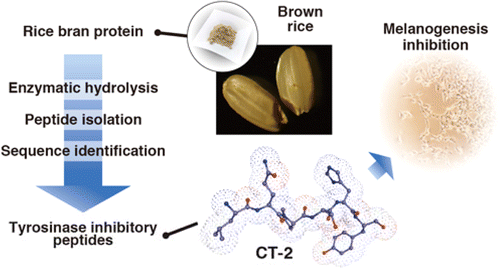当前位置:
X-MOL 学术
›
J. Nat. Prod.
›
论文详情
Our official English website, www.x-mol.net, welcomes your
feedback! (Note: you will need to create a separate account there.)
Rice Bran Protein as a Potent Source of Antimelanogenic Peptides with Tyrosinase Inhibitory Activity
Journal of Natural Products ( IF 3.3 ) Pub Date : 2016-09-20 00:00:00 , DOI: 10.1021/acs.jnatprod.6b00449 Akihito Ochiai 1 , Seiya Tanaka 1 , Takaaki Tanaka 1 , Masayuki Taniguchi 1
Journal of Natural Products ( IF 3.3 ) Pub Date : 2016-09-20 00:00:00 , DOI: 10.1021/acs.jnatprod.6b00449 Akihito Ochiai 1 , Seiya Tanaka 1 , Takaaki Tanaka 1 , Masayuki Taniguchi 1
Affiliation

|
Rice (Oryza sativa) is consumed as a staple food globally, and rice bran, the byproduct, is an unused biomass that is ultimately discarded as waste. Thus, in the present study, a technique for producing tyrosinase inhibitory peptides from rice bran protein (RBP) was developed. Simultaneous treatment of RBP with chymotrypsin and trypsin produced numerous peptides. Subsequently, six tyrosinase inhibitory peptides were isolated from the hydrolysate fractions in a multistep purification protocol, and their amino acid sequences were determined. Three of these peptides had a C-terminal tyrosine residue and exhibited significant inhibitory effects against tyrosinase-mediated monophenolase reactions. Furthermore, peptide CT-2 (Leu–Gln–Pro–Ser–His–Tyr) potently inhibited melanogenesis in mouse B16 melanoma cells without causing cytotoxicity, suggesting the potential of CT-2 as an agent for melanin-related skin disorder treatment. The present data indicate that RBP is a potent source of tyrosinase inhibitory peptides and that simultaneous treatment of RBP with chymotrypsin and trypsin efficiently produces these peptides.
中文翻译:

米糠蛋白作为具有酪氨酸酶抑制活性的anlanlanogenic肽的有效来源。
水稻(水稻)作为全球主要食品消费,副产品米糠是一种未使用的生物质,最终被当作废物丢弃。因此,在本研究中,开发了由米糠蛋白(RBP)产生酪氨酸酶抑制肽的技术。用胰凝乳蛋白酶和胰蛋白酶同时处理RBP产生了许多肽。随后,在多步纯化方案中从水解产物级分中分离出六个酪氨酸酶抑制肽,并确定了它们的氨基酸序列。这些肽中的三个具有C端酪氨酸残基,并表现出对酪氨酸酶介导的单酚酶反应的显着抑制作用。此外,肽CT-2(Leu–Gln–Pro–Ser–His–Tyr)可以有效抑制小鼠B16黑色素瘤细胞中的黑色素生成,而不会引起细胞毒性,提示CT-2作为黑色素相关性皮肤病治疗剂的潜力。本数据表明RBP是酪氨酸酶抑制肽的有效来源,并且用糜蛋白酶和胰蛋白酶同时处理RBP可以有效地产生这些肽。
更新日期:2016-09-20
中文翻译:

米糠蛋白作为具有酪氨酸酶抑制活性的anlanlanogenic肽的有效来源。
水稻(水稻)作为全球主要食品消费,副产品米糠是一种未使用的生物质,最终被当作废物丢弃。因此,在本研究中,开发了由米糠蛋白(RBP)产生酪氨酸酶抑制肽的技术。用胰凝乳蛋白酶和胰蛋白酶同时处理RBP产生了许多肽。随后,在多步纯化方案中从水解产物级分中分离出六个酪氨酸酶抑制肽,并确定了它们的氨基酸序列。这些肽中的三个具有C端酪氨酸残基,并表现出对酪氨酸酶介导的单酚酶反应的显着抑制作用。此外,肽CT-2(Leu–Gln–Pro–Ser–His–Tyr)可以有效抑制小鼠B16黑色素瘤细胞中的黑色素生成,而不会引起细胞毒性,提示CT-2作为黑色素相关性皮肤病治疗剂的潜力。本数据表明RBP是酪氨酸酶抑制肽的有效来源,并且用糜蛋白酶和胰蛋白酶同时处理RBP可以有效地产生这些肽。
















































 京公网安备 11010802027423号
京公网安备 11010802027423号